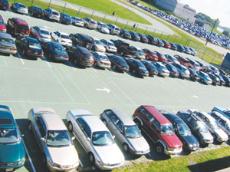UMass Boston’s eight tennis courts were sacrificed over the summer to meet the campus’s urgent need for parking. In place of where the 1.3 acre courts had stood for over two decades, is a parking lot that sports roughly 170 spaces, and is ironically named Beacons Lot A, in tribute to the campus’s sports teams and mascot.
The events that led to the tennis court’s termination and the resignation of the men’s and women’s tennis coach, unfolded after the main garage was ordered closed on July 19th. Several emergency parking meetings, attended by high ranking administrators met from July to September to address strategies for parking relocation. None of the six campus officials who were contacted for this story responded.
One Athletics official who spoke on condition of anonymity said his department didn’t have much of a say on the matter, and recalled how the “Administration & Finance Office basically drew up a map of possible [recreational] sites that could be turned into parking, and advised Athletics to choose which site they could best handle losing.”
The decision to turn the tennis courts into parking lacked student feedback, even though university governing policies exist that afford them opportunities to express input in major infrastructure matters. One such policy is the UMass Board of Trustees document T 73-098 that states, “Students have the right, and privilege of advising on polices affecting the University [and] students will have primary responsibility for services and activities that are designed primarily to serve students or…are primarily financed by students.”
Tennis, like other on-campus recreational activities are partly student funded by a mandatory Athletics Fee of $88.50.
Athletics & Recreation Vice Chancellor Charlie Titus stated, “Students were not involved in the decision about the tennis courts”, adding, “There simply wasn’t enough time at that point in the summer to get input from student leaders.” Titus explained that an arrangement had since been made with neighboring BC High School that would enable the women’s tennis team to play their fall season on their five courts.
BC High Athletics director John Bartlett confirmed that arrangement. It is still uncertain where exactly the UMB men’s tennis team will play, since their season will conflict with BC High’s tennis season in the spring. Student Senator and Trustee, Alex Kulenovic, who attended the last two emergency parking meetings, indicated the decision to gut the courts occurred in earlier meetings that he did not attend.
“It was also a temporary measure that will hopefully be reversed soon,” Kulenovic asserted. Such sentiments may be wishful thinking however, since a revised Parking & Transportation pamphlet listing the locations and types of parking, does not classify Beacons Lot A as a temporary lot as it does with others.
While Kulenovic was unaware of the BC High arrangement, he said it would be nice of BC High to allow local residents to use them too, like UMB had done. As to whether the $88.50 mandatory Athletics Fee should be lowered to reflect the loss of an on-campus recreational activity, Kulenovic replied, “If students want to pursue this matter, than their student government should hear them out.”
Student Senate President Mike Metzger stated by email that his main concern about the parking relocation, “was to see as many students park on campus as possible.” While not commenting on the loss of the tennis courts, Metzger did commend the efforts of the Administration & Finance Office’s team for responding to the parking shortage in such a short time-frame.
The embattled Beacons tennis teams have struggled in recent years for competitive wins in the Little East Conference and even for the survival of the teams themselves. In 2004 Athletics cut the entire women’s team season because it lacked the players required for their first five games. As with other on-campus extra-curricular activities, UMB’s sports teams have struggled with maintaining student involvement at UMass’s sole commuter campus.
Former men’s and women’s tennis coach Jim McBurnie relayed his frustrations over trying to recruit and maintain student players in the past. “Not enough women turned out at the start of the [fall] season, and the lack of a team resulted in my decision to step away.” Kristin Cirbus, who has over 12 years of instructional experience in ice hockey, is currently serving as the women’s tennis coach.
Studies show that collegiate tennis has declined nationwide. In one national study, the Intercollegiate Tennis Association found that a whopping 546 men’s and women’s tennis teams had been eliminated throughout the U.S. over the past 10 years. Some factors the ITA found that contributed to the extinction of college tennis were “escalating costs, shrinking budgets, and tennis court’s usage of valuable real estate.”
When UMass Dartmouth recently experienced a need for more real estate space to build dorms, tennis courts were still given a priority. UMD Director of Athletic Facilities Jim Filippo explained that when plans commenced to build new dorm on the site of their two tennis courts that an arrangement was made to construct ten new tennis courts at a different location.
While the original costs of UMB’s tennis courts was not readily available, a past Mass Media story from January 1983 cited a related price-tag of $582,000 for new outdoor athletic facilities, including a track, soccer and softball fields, and the tennis courts.
According to several official campus websites and informational maps, the legacy of UMass Boston’s tennis courts lives on, as the non-existence of the eight courts has not been updated.





















































